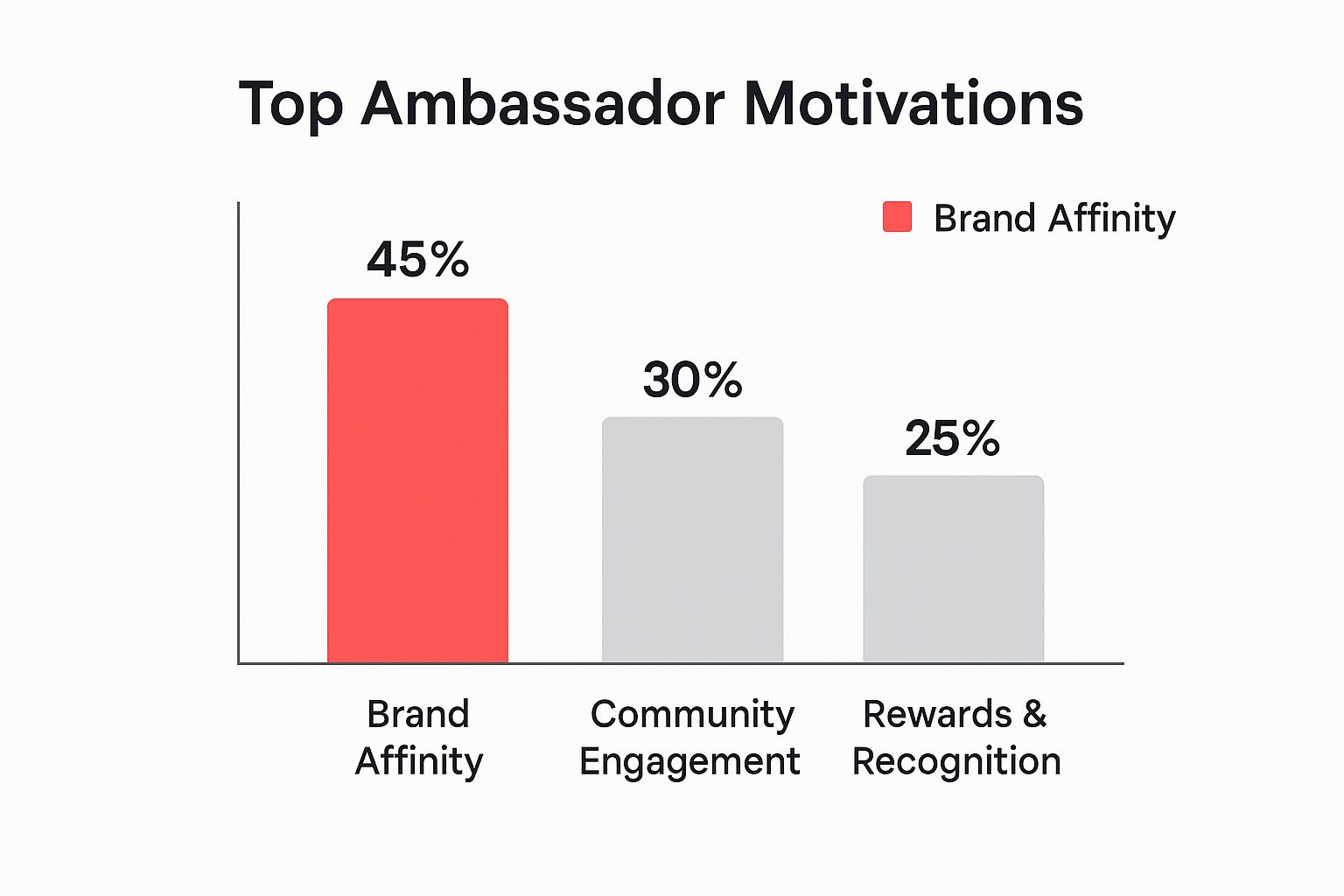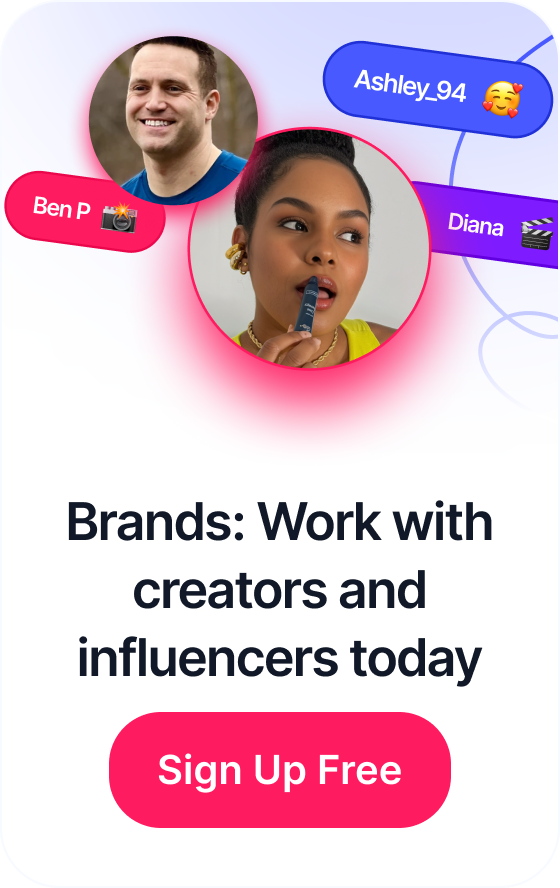 Influencer Brief Template: Create Campaigns That Convert
Influencer Brief Template: Create Campaigns That Convert
Table of Contents
Understanding Why Ambassador Programs Actually Work

Many businesses are now seeing that quick viral hits don’t build value like real, heartfelt support does. This change in thinking is steering companies away from short-term influencer deals and towards creating solid ambassador programs.
If you’re looking into how to build an ambassador program that truly makes a difference, it’s important to first grasp why they are so successful.
The Power of Authentic Connection
The heart of successful ambassador programs lies in their realness. Unlike a single sponsored post, ambassadors usually already like and use the brand they talk about. This authentic enthusiasm makes their recommendations feel more personal and believable to their followers.
When people hear from someone who genuinely uses and enjoys a product, it stands out from typical ads. This genuine connection builds trust that’s hard to get any other way, forming a key part of why these ambassador approaches work.
Cultivating Sustainable Engagement
Another big plus for these programs is how they build sustainable engagement. They aren’t about quick, one-time promotions often seen in marketing. Instead, ambassador programs focus on developing long-lasting relationships.
This ongoing teamwork results in a consistent flow of content and conversations. This keeps the brand visible and relevant in the ambassador’s circle. Imagine an ambassador sharing how they use a product over several months; it’s more like a continuing story than a sales pitch, helping to create a dedicated audience for the brand.
Additionally, ambassador programs are often a very cost-effective way to scale marketing efforts. Instead of spending big on paid advertisements, brands work with enthusiastic people who naturally share their positive experiences. Recent data really brings this financial benefit to light.
For instance, in 2025, brand ambassador programs are noted as the top return on investment (ROI) channel for brands using influencer marketing. This shows just how valuable these long-term connections are, particularly as the entire influencer marketing field is expected to reach an impressive $47.8 billion by 2027. You can find more details on this development in Aspire’s 7th annual industry benchmark report.
This emphasis on real, continuous relationships boosts genuineness and also leads to a strong return on investment. To see how well your ambassador program is doing and to show its worth, you’ll need to monitor key numbers, just like with any other marketing activity.
Getting a handle on campaign performance metrics is vital for tweaking your strategy. It ensures your program effectively helps meet your larger business objectives.
Setting Clear Goals That Drive Real Business Results
Figuring out what success truly means for your brand is the very first, and perhaps most important, step when you’re looking at how to build an ambassador program that genuinely contributes to your business. It’s important to move past broad ideas like simply ‘boosting brand awareness’. Instead, concentrate on definite, trackable results, such as aiming to increase customer acquisition by a specific percentage or improving customer retention figures. These well-defined aims will serve as the bedrock for your entire program’s plan.
To get this level of clarity, it’s wise to set SMART objectives. This framework helps turn general aspirations into focused, actionable targets:
- Specific: Pinpoint exactly what you aim to achieve. For example, rather than just “more engagement,” a specific goal would be to “increase user-generated content submissions by 30%.”
- Measurable: Make sure you have a way to track your progress and measure how successful you are.
- Achievable: Set goals that are realistic, considering your available resources and current market conditions.
- Relevant: Ensure your ambassador program’s goals are in line with your company’s wider business objectives.
- Time-bound: Assign a clear deadline for when you expect to reach these objectives.
Using this approach helps transform vague wishes into concrete targets that really make a difference to your business.
Aligning Program Structure with Strategic Goals
Once you’ve clearly defined your objectives, you can then decide on the best structure for your ambassador program. Different goals will naturally lead to different kinds of ambassador activities. For instance, if achieving quick market entry is a primary aim, then a widespread network of ambassadors might be the most effective approach.
Think about how these structures align with common goals:
- Micro-influencer networks can be particularly effective if your aim is to connect with specialized audiences or to produce a large amount of genuine content across different platforms.
- Customer advocacy initiatives, which concentrate on your most devoted customers, are excellent for fostering trust, collecting believable testimonials, and encouraging sales through word-of-mouth.
- Employee ambassador strategies can greatly enhance your image as an employer and offer an authentic voice, especially if your company’s internal culture and industry knowledge are key to your objectives.
This increasing dedication from brands highlights why clearly defined objectives are so vital when you build an ambassador program. In fact, with 73% of US and UK marketers intending to increase their investment in brand ambassadors in the upcoming year because of their established advantages, a solid strategy is essential to both justify and get the most out of this expenditure. Explore more insights about this rising marketer priority.
Lastly, formally documenting these clearly defined goals in a program charter can be very beneficial. This document should detail the program’s main purpose, its objectives, the key performance indicators (KPIs) you’ll use to track success, and the results you expect. Such a charter is extremely useful for getting support from leadership and securing the budget needed for a successful program launch.
Finding Ambassadors Who Genuinely Connect With Your Brand
When you’re figuring out how to build an ambassador program, discovering the right individuals is truly essential. It’s about looking past simple follower numbers to find people who genuinely share and reflect your brand’s core values. This deeper connection forms the foundation of a successful partnership, leading to more believable endorsements.
A great starting point is your existing customer base. These individuals already know and appreciate your products, making them prime candidates for authentic ambassadorship. Additionally, strategic social media discovery allows you to identify potential advocates who are actively talking about your industry or similar products with genuine enthusiasm.
As you identify potential ambassadors, evaluating them effectively is key. Focus on the quality of their engagement rather than just the quantity. Authentic audience interaction and a genuine brand affinity are far more valuable than inflated vanity metrics, ensuring their recommendations resonate truthfully.
Understanding what motivates these individuals can significantly refine your search. The following visual breaks down the primary drivers for brand ambassadors.
This data highlights that brand affinity (45%) is the leading motivator, reinforcing the importance of finding ambassadors who already love your brand. Community engagement and rewards also play significant roles, guiding how you structure your outreach and program benefits.
Before diving into the specifics of recruitment, it’s useful to consider where you can find these potential partners. The table below compares various channels for ambassador recruitment, outlining their typical reach, cost, and the potential quality of candidates.
Ambassador Recruitment Channel Comparison
A comparison of different recruitment channels showing reach, cost, quality, and best use cases for finding potential ambassadors
| Channel | Average Reach | Cost Level | Quality Score | Best For |
|---|---|---|---|---|
| Existing Customer Base | Low to Medium | Low | Very High | Genuine testimonials, building initial loyalty |
| Social Media Listening | Medium to High | Moderate | High | Identifying organic advocates, passionate users |
| Ambassador Platforms | High | Moderate to High | Variable | Scaling programs, specific demographic targeting |
| Employee Advocacy | Medium | Low | High | Internal champions, authentic brand voice |
| Niche Online Communities | Low to Medium | Low to Moderate | Very High | Highly engaged experts, subject matter enthusiasts |
As the table illustrates, the “best” channel really depends on your program’s specific needs and resources. Tapping into your existing customer base can yield high-quality ambassadors at a low cost, while social media listening is excellent for finding people who are already talking positively about your brand or industry.
Practical Recruitment and Vetting
A systematic approach to recruitment is vital when you build an ambassador program, ensuring you select individuals truly aligned with your brand. Key steps include:
- Developing compelling outreach messages. These should be personalized and clearly explain your program’s value and the benefits of partnering up.
- Conducting thorough screening of potential candidates. This means reviewing their social media for authenticity, the quality of their engagement, and whether their audience demographics align with your target.
- Holding insightful interviews to gauge genuine passion. Using scenario-based questions here can reveal how an individual might authentically represent your brand in different situations.
This structured selection is very important. Interestingly, passionate micro-influencers often yield better results than celebrity partnerships due to their niche audiences and relatable personas leading to higher engagement. You might be interested in learning more about how to find the right influencers for your brand in this detailed guide.
Finally, learning to spot red flags early saves you from unproductive or even damaging associations. Watch for inauthentic engagement (like a high number of bot followers), controversial past partnerships, or a clear misalignment with your brand’s ethical standards. This careful vetting builds a strong, authentic foundation for your program.
Designing Incentives That Motivate Long-Term Commitment

Keeping ambassadors engaged long-term is where a strong program truly proves its worth, beyond just initial excitement. Long-term commitment isn’t accidental; it’s nurtured by offering genuine value that surpasses simple cash rewards. This means designing an incentive system that really connects with your ambassadors, making them feel like essential contributors to your brand’s story.
Moving Beyond Just Monetary Rewards
If incentives are only cash or free products, it can feel transactional. To foster authentic enthusiasm, many brands use non-monetary perks for a stronger emotional connection. For instance, exclusive access to behind-the-scenes content, product previews, or chats with leaders makes ambassadors feel like true insiders.
This shifts the focus from a simple exchange to a genuine partnership. Receiving early product releases gives ambassadors more than a tangible item; it offers ‘insider’ status. Sharing this with their communities enhances their credibility and your brand’s visibility.
Structuring Tangible Rewards and Recognition
While non-monetary perks are key, tangible rewards are also vital, especially to build an ambassador program appealing to many. Commission-based rewards directly connect effort to earnings, great for sales goals. Free products or big discounts also acknowledge contributions practically.
And don’t forget the power of public recognition. Social media shout-outs, blog features, or ambassador awards can significantly lift morale and loyalty. These gestures validate their work publicly. A tiered system, where milestones unlock better rewards, can also keep ambassadors striving for more.
The main idea is to provide a variety of incentives that cater to diverse motivations.
| Incentive Category | Primary Motivator | Examples |
|---|---|---|
| Experiential | Exclusivity, Insider Feel | Early product access, VIP event invites |
| Material | Tangible Benefit, Value | Free products, commission, exclusive discounts |
| Recognition | Appreciation, Visibility | Social media features, ambassador of the month |
| Developmental | Growth, Connection | Skill-building workshops, networking with peers |
This balanced mix ensures your program offers something valuable for everyone, increasing its overall appeal and effectiveness.
Ensuring Financial Sustainability and Fairness
When designing incentives, ensuring the program is financially sustainable is essential. This involves carefully calculating fair compensation that mirrors the value ambassadors provide—like increased brand awareness, quality user-generated content, or direct sales—all while fitting your budget.
To keep this balance, set up straightforward methods for weighing program costs against anticipated returns. Clear performance metrics for various reward levels can help. For example, link higher-value incentives to major achievements, so expenses align with business contributions. Such thoughtful cost management is key when you build an ambassador program meant to last.
Creating Guidelines That Enable Authentic Content
Good incentives are great for keeping ambassadors on board for the long haul. But once that’s sorted, the next big move when you build an ambassador program is setting up rules that help your ambassadors make authentic content that truly connects with people.
It’s all about finding that sweet spot – keeping your brand looking good while letting each ambassador’s real personality shine through. This is super important because for their recommendations to work, they have to come across as genuine.
Balancing Brand Integrity With Creative Voice
The best ambassador programs offer a supportive structure, not a rigid set of commands. You need clear guidelines for brand consistency so your main message and company values are shown correctly.
However, these rules shouldn’t restrict the creative freedom that gives ambassador content its special appeal. It’s like giving them the main ideas and brand visuals, but letting them tell the story in their own way.
This careful mix is key for keeping your audience’s trust. Imagine if a tech reviewer famous for funny takes suddenly drops a stiff, corporate-style video for your product – their followers would definitely pick up on it. The idea is to have content that fits naturally with how they usually talk to their audience.
Crafting Inspiring Content Briefs
To help steer this creative work, create content briefs that spark ideas, not shut them down. A strong brief won’t insist on exact wording. Instead, it will lay out the campaign’s aims, who you’re trying to reach, the main messages, and any must-haves like specific hashtags or links. It could also offer suggestions for the tone or themes for the content.
Think about putting these in your briefs:
- Campaign Goals: What’s the content supposed to do (e.g., build awareness, get people talking, drive sign-ups)?
- Key Message Points: What are the 1-3 most important things people should remember?
- Tone of Voice: Should it be fun, educational, or motivational?
- Visual Guidelines: Any particular looks or brand items to feature.
- Call to Action: What’s the next step for the audience?
- Do’s and Don’ts: Clear limits on what’s okay and what’s not.
These briefs should serve as a guide, showing ambassadors the general direction while giving them the freedom to get there using their own creative approach.
Ensuring Compliance And Legal Clarity
A really important piece of your guidelines covers the legal and ethical side of things, especially disclosure requirements. Ambassadors need to be upfront with their followers when a post is sponsored. This usually means using hashtags such as #ad, #sponsored, or the disclosure tools provided by social media platforms.
Being open and honest is a must. In fact, 78% of consumers say a brand’s activity on social media makes a big difference in how much they trust it. If disclosures aren’t handled correctly, it can seriously hurt the trustworthiness of both the ambassador and your brand. So, giving clear, easy-to-follow instructions on how to comply is essential for your program.
Streamlining Content Operations
When you build an ambassador program designed to grow, having sensible systems for handling content becomes more and more critical. Set up straightforward content approval workflows so ambassadors understand the process for submitting content for a look-over, if that’s part of your plan. This could be a shared online folder, an email system, or tools within a dedicated ambassador platform.
Also, make sure your brand assets – things like logos, product photos, and pre-approved text – are simple to find and use. A neat digital collection of these items saves everyone time and helps ambassadors use the right, top-notch materials. Good coordination for campaigns, maybe using a shared schedule or frequent update messages, helps keep everyone on the same page.
In the end, these guidelines and systems are all about encouraging the creation of engaging user-generated content (UGC). This kind of content should feel natural and really resonate with people. To learn more about making the most of this influential type of social proof, take a look at our guide on developing an effective user-generated content strategy.
Building Systems That Scale Without Losing the Personal Touch

Growing your ambassador program is exciting, but it brings a big question: how do you manage more people without losing that personal connection? The answer lies in a smart operational system. When you build an ambassador program with growth in mind, this system is what keeps things running smoothly, ensuring your authentic relationships, the heart of your program, stay strong.
Choosing the Right Management Platform
Picking the right tools is a critical first step in setting up these efficient systems. For programs just starting out, a basic Customer Relationship Management (CRM) system, like the free tools offered by HubSpot CRM, can be enough to keep track of chats and ambassador details. But as your numbers grow, you’ll likely need to look into dedicated ambassador management software.
These platforms are built specifically for ambassador programs, offering features for finding new ambassadors, talking with them, tracking campaigns, and handling rewards, all in one spot. For example, a dedicated platform can handle payments automatically, which gets really tricky with lots of ambassadors. The main thing is to pick a solution that works for you now and can also handle more as your program gets bigger.
Better Communication and Engagement
Keeping in touch regularly and meaningfully is essential for any ambassador program. Good onboarding sequences are super important for making sure new ambassadors know what to expect and have what they need right from the start. Systems can help automate some of this, making sure every new member gets the right info and tools to hit the ground running.
After onboarding, things like regular check-ins and community-building efforts keep ambassadors involved and feeling appreciated. Platforms can help with this by offering built-in messaging, forums, or tools to help you schedule personal messages. It’s like having a helper who makes sure no ambassador gets overlooked, even when your program is growing fast. This organized way of doing things helps keep a strong sense of community alive.
Boosting Efficiency With Workflow Automation
If you want to keep personal connections strong as you grow, you need to free up your time from doing the same admin tasks over and over. This is where workflow automation really shines. Setting up automatic processes for things like content submission reminders, creating performance reports, or even doing an initial review of applicants can save a lot of admin time. This gives you more time to focus on strategy and building relationships.
For example, integrated content scheduling tools—you might know services like Buffer—can assist in coordinating campaign launches across multiple ambassadors without laborious manual back-and-forth. Similarly, clear coordination strategies, supported by shared calendars or project management features, perhaps similar to what you’d find in a tool like Trello, ensure everyone is aligned on deliverables and timelines. This kind of efficiency doesn’t make your program less personal; it actually gives you more time to build real connections and offer personal support, which is so important when you build an ambassador program designed to succeed long-term.
Measuring Success and Optimizing for Maximum Impact
So, you’ve got your ambassador program systems set up. What’s next? To truly understand how to build an ambassador program that offers real, lasting value, you need to keep a close eye on its success and constantly look for ways to make it even better. Using data to guide your decisions can turn a pretty good program into an outstanding one, making sure your hard work leads to actual business results, not just a feeling of being busy. It’s about digging deeper than the obvious numbers to see what your data is genuinely revealing.
Defining Your Key Performance Indicators (KPIs)
To really know how well your program is doing, you first need to set up some Key Performance Indicators (KPIs). These are the specific numbers that match up with the goals you laid out when you started. Think of KPIs as your guide; they’ll show you where to focus your improvements. What does success actually mean for you? Is it more people talking about your brand, deeper engagement with your content, more sales, or perhaps better customer loyalty?
Good measurement and a solid look at the numbers are super important. This kind of focus doesn’t just make your marketing sharper; it also has a big positive effect on the overall health of your business. For instance, research from sources like StackInfluence shows that companies with strong brand recognition and effective ambassador programs see a 31% lower voluntary turnover rate. That really highlights how valuable building ambassador loyalty can be.
To give you a clearer picture, here’s a breakdown of some common KPIs you might track, covering everything from getting your name out there to making actual sales.
Key Performance Indicators for Ambassador Programs
Essential metrics to track ambassador program performance across awareness, engagement, and conversion goals
| Metric Category | Key Indicators | Measurement Method | Success Benchmark (Example) |
|---|---|---|---|
| Awareness | Reach, Impressions, Brand Mentions | Social listening tools, Platform analytics | 20% increase in reach month-over-month |
| Engagement | Likes, Comments, Shares, Engagement Rate, UGC Volume | Social media analytics, Ambassador platform reports | Engagement rate >3%, 50+ UGC pieces/month |
| Conversion | Clicks, Leads, Sales, Conversion Rate, Sign-ups | UTM tracking, Affiliate links, Promo code usage | 10% conversion rate from ambassador traffic |
| Program Health | Ambassador Activity Rate, Retention Rate | Program dashboard, Surveys | 80% active ambassadors, 90% retention YoY |
Having this kind of framework helps you see exactly what’s driving results and where you might need to adjust your strategy for even better outcomes.
Beyond Vanity Metrics: True Attribution and ROI
It’s easy to get caught up in numbers like follower counts or likes, and while they give a quick glimpse, the true program impact really shows up when you look closely at attribution and Return on Investment (ROI). You need proper attribution models in place to clearly link what your ambassadors do to actual business results, like sales or new customers. Think about using unique discount codes, UTM parameters on links they share, or even special landing pages just for traffic they send your way.
Looking at the customer lifetime value (CLV) of customers brought in by your ambassadors can also offer great insights into the program’s long-term financial benefits. Figuring out the ROI is key to showing why your program deserves continued support and resources. If you want to dig deeper into this, you might find it helpful to learn more about How to Master Influencer Marketing ROI.
Tools and Processes for Ongoing Optimization
If you want your ambassador program to keep succeeding long-term, you have to keep an eye on it and make smart changes along the way. Use performance monitoring tools to track your KPIs; these might be part of an ambassador platform or separate analytics services. Doing regular, systematic program audits, say every quarter, can help you spot trends, see what’s not working as well as it could, and find new chances to make things better.
This focus on data allows for strategic optimization. For example, if you notice that particular kinds of content or certain ambassadors are getting much better results, you can tweak your plan to lean into what’s working. And as you get your program management running smoothly, it’s also worth looking into ways to improve team productivity for the people running the show, making sure everything is efficient.
The Power of Ambassador Feedback
Lastly, don’t forget that your ambassadors themselves are a goldmine of information. Make it a point to actively gather meaningful feedback from them. Ask about their experience with the program, what they think of the resources you give them, and any hurdles they’re running into.
You can collect this valuable input through several methods:
- Sending out regular surveys
- Having one-on-one chats or check-ins
- Setting up a dedicated channel just for feedback
Listening to their thoughts and using those insights to improve program satisfaction is a big deal. It doesn’t just help you keep your top ambassadors happy and engaged; it also boosts the long-term effectiveness of your whole ambassador program. They’re the ones in the trenches, so they often have practical ideas you wouldn’t have thought of.
By consistently measuring, carefully analyzing, and thoughtfully optimizing, you’ll make sure your ambassador program continues to be a lively and valuable part of your brand’s success.
Ready to build an ambassador program that scales and delivers measurable results? Discover how JoinBrands can connect you with over 250,000+ creators and streamline your campaign management today!








